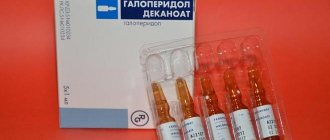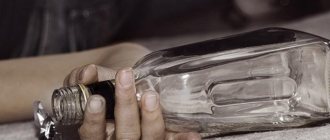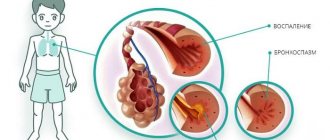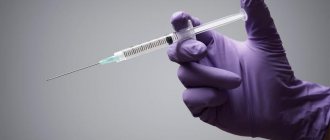4.9
(27)
Ascorbic acid is essential for human health, and its deficiency can be dangerous. Many vegetables and fruits are rich in vitamin C, but in some cases the diet is not enough, and doctors prescribe ascorbic acid in ampoules.
Ascorbic acid in ampoules helps regulate carbohydrate metabolism.
pharmachologic effect
The functions of vitamin C are not limited to strengthening the immune system. The active substance provides vital processes:
- Tissue restoration.
- Blood clotting.
- Carbohydrate metabolism.
- Synthesis of steroid hormones (corticosteroids and sex hormones).
- Redox reactions.
Ascorbic acid ensures the exchange of pigments, amino acids, and cholesterol. Promotes the accumulation of glycogen in the liver. Improves bile secretion, restores pancreatic function. Ascorbic acid is a strong antioxidant; it reduces the permeability of small blood vessels (capillaries), increases the body's resistance to infections by activating the synthesis of interferon and antibodies. Absorption of the substance occurs in the small intestine, excretion is carried out by the kidneys, partly by the skin and gastrointestinal tract.
Benefits of ascorbic acid
Once in the human body, ascorbic acid performs many important functions:
- helps stimulate metabolism;
- stimulates redox processes;
- supports the functioning of the blood coagulation system;
- regulates carbohydrate metabolism;
- promotes healing and restoration of tissues, fusion of bones after a fracture;
- participates in strengthening the immune system;
- improves the functioning of the pancreas and thyroid gland;
- stimulates the process of removing bile from the gallbladder;
- helps suppress allergic and inflammatory reactions in the body;
- helps eliminate cholesterol
When using vitamin C injections, all beneficial substances enter directly into the bloodstream without passing through the stomach and digestive system. The drug in the form of injections works faster and more effectively than tablets.
Application
Intravenous injections of vitamin C ensure its rapid entry into the body and inclusion in metabolic processes, which distinguishes this pharmacological form from powders and tablets. The prescription is made by a doctor, and the injection into the body is carried out according to the instructions. Indications for use are the following diseases and conditions:
- scurvy;
- tuberculosis;
- Gastrointestinal diseases (diarrhea, peptic ulcer);
- radiation sickness;
- hypovitaminosis (deficiency);
- vitamin deficiency (absence);
- bleeding (nasal, pulmonary, liver);
- intense mental work;
- excessive physical activity;
- prolonged hypothermia of the body;
- rehabilitation period after injuries and operations;
- injection of nutrients (parenteral nutrition);
- chronic intoxication;
- alcoholism treatment;
- quitting smoking;
- recovery from stress.
After an injection of vitamin C, it enters all cells of the body. The endocrine glands accumulate it in the greatest concentration. When ingested, ascorbic acid activates the following processes:
- regulates immune reactions, improves immunity;
- exhibits antiallergic, anti-inflammatory effects;
- accelerates the metabolism of proteins, fats and carbohydrates;
- provides tissue respiration;
- preserves health and youth of skin, hair, nails.
Ascorbic acid is effective in treating anemia, which is caused by a lack of iron. This is the most common type of disease. There is anemia due to a lack of folic acid, hemolytic anemia, in which red blood cells are destroyed very quickly, and other types. Ascorbic acid helps the absorption of iron and other vital substances well. Taking this medicine helps a weakened body recover quickly.
With long-term treatment with antibiotics (for example, benzylpenicillin), the natural microflora is suppressed and fungal infections develop. To maintain and restore the body, B vitamins and ascorbic acid are prescribed. The substance has a beneficial effect on skin and hair. It activates the synthesis of procollagen, and then collagen (the main protein of the skin, which gives it elasticity). To restore hair health, an ampoule of ascorbic acid solution is added to shampoo or a nourishing mask.
There is an opinion that ascorbic acid helps to lose weight. Weight regulation with the help of this substance will be effective only if you follow a special diet, sufficient physical activity and correct use of the drug. Taking the medicine before meals reduces appetite. A strong feeling of hunger occurs if ascorbic acid is taken after a meal. The effectiveness of the substance does not increase if its dosage is increased. This is important to remember for those who want to lose excess weight.
Deficiency Symptoms
Before prescribing a vitamin preparation, the doctor pays attention to primary signs that indicate the need to urgently replenish vitamin C reserves:
- pale, dry and sagging skin;
- dry and brittle hair and nails;
- the presence of long-healing wounds;
- general weakness, poor sleep, increased anxiety, irritability or depression;
- bleeding gums and loose teeth;
- weak immunity;
- the normal functioning of the gastrointestinal tract is disrupted;
- slow metabolism, which leads to rapid weight gain;
- hypertension and tachycardia;
- pain in the muscles and joints that limits the movement of the limbs.
At the initial stage, vitamin deficiency is difficult to diagnose; symptoms may indicate the presence of another disease. A characteristic feature of a lack of vitamin C in the body is the fragility of blood vessels. This condition is accompanied by frequent nosebleeds and the formation of bruises on the skin even from weak blows.
Instructions for the use of ascorbic acid in ampoules
Vitamins enter the human body with food and as part of special medications. Special courses of treatment help replenish vital substances. Doctors prescribe vitamin C in ampoules in special cases. The content of ascorbic acid in 1 ml of solution is from 50 to 100 mg. Ampoule volume 1-2 ml. A single administration of the substance should not exceed 200 mg. Injections are given intravenously or intramuscularly.
For face
Professional cosmetology widely uses vitamin C to heal and rejuvenate facial skin. It becomes elastic, wrinkles disappear. Skin saturated with ascorbic acid responds better to cosmetic procedures. It more actively absorbs beneficial substances from moisturizing and nourishing creams and masks. Vitamin C is no less effective for the face if used correctly at home. Under the influence of the substance, the skin is transformed:
- improves complexion;
- rashes disappear;
- cells are actively renewed;
- nutrition of the epidermis (upper layer of skin) is normalized;
- peeling and redness stop;
- capillaries narrow.
To achieve a cosmetic effect, it is recommended to use a specially prepared vitamin mask. It is important to adhere to the following recommendations:
- The most powerful effect is provided by the combination of vitamins A, E, C.
- When mixing components, do not use metal utensils. When interacting with it, ascorbic acid is destroyed.
- Before using the mask, your facial skin must be thoroughly cleansed.
- The mask should not be applied to damaged skin or areas around the eyes.
- Fresh fruits enhance the effect of the mask.
- It is better to make a vitamin mask before bed.
- Apply the solution from the ampoule to the skin of the face, hold for 10 minutes, wipe the face with tonic, apply night cream.
- The liquid form of ascorbic acid is an excellent product for nourishing facial skin. The medicinal solution is used as an independent remedy and in combination with other substances.
- You can use the mask no more than 2 times a week. The procedures are performed in courses, with a 4-5 week break between them. The duration of the course depends on the condition of the skin.
Liquid ascorbic acid with yogurt and sugar can be applied to the skin around the eyes. The composition is applied with a cotton swab after the ingredients have completely dissolved. Pure and mixed formulations must be used with caution. Allergic reactions may occur. Cosmetologists prescribe vitamin C injections along with natural collagen, natural plant extracts, and hyaluronic acid.
If used incorrectly or when preparing homemade masks with ascorbic acid solution, it is not always possible to achieve the desired effect. The main consequences of the “wrong” homemade masks:
- Uselessness. Disappointing but harmless result. This reaction is associated with the wrong choice of base for the mask. Vitamin C has a better effect on the skin when combined with glycerin or propylene glycol.
- Irritations. If the drug is diluted incorrectly with water, the acidity level decreases (pH about 2.2). Ascorbic acid penetrates the epidermis better in an acidic environment (pH 2.8-3.4).
- Spoiled medicine. Ascorbic acid is the active substance. It is destroyed by heat, light, and air, so homemade masks are stored for 1-2 days in the refrigerator in an airtight container.
- Inefficiency. Homemade masks are poor in composition. The effectiveness of vitamin C is higher when used simultaneously with vitamin E and ferulic acid.
- Consultation with a nutritionist - why is it needed? Advice from the best nutritionists for weight loss for adults and children
- Carp in the oven: recipes with photos
- Noodle soup - recipes step by step with photos. How to prepare homemade noodles for chicken, mushroom or Chinese soup
Vitamin C intramuscularly
To quickly replenish vitamin C deficiency, in some diseases and conditions when the intake of the substance from food, in the form of tablets and powders is impossible, injections of a 5% solution of ascorbic acid are prescribed intramuscularly. The treatment regimen is prescribed by a doctor. It depends on the diagnosis and severity of the patient’s condition. The therapeutic dose is:
| Age category | Maximum single dose | Number of injections | Maximum daily dose |
| Children | 0.6-1.0 ml | 1-2 | 1-2 ml |
| Adults | 1.0-5.0 ml | 1-3 | 20 ml |
Dosage form and composition of solution
The pharmaceutical preparation “Ascorbic acid” is available in the following forms:
- dragee;
- tablets for children, adults;
- powder;
- injection solution.
The latter form is a colorless liquid, sometimes it is slightly yellow. The substance in the ampoules must be transparent.
The active ingredient is ascorbic acid. Its quantity in ampoules of 1 ml is 50 milligrams, in 2 ml - 100. Substances such as sodium bicarbonate and sulfite (or metabisulfite), Trilon B, and liquid for injection are used as auxiliary substances.
How to give injections
Vitamin C is administered intravenously or intramuscularly. In the first case, it is better to seek help from specialists, in the second, you can do the injection yourself. Before the procedure, hands must be thoroughly washed with soap and treated with any disinfectant. Intramuscular injection involves the following steps:
- Treat the skin with an antiseptic to prevent possible inflammation.
- Slowly inject the solution into the muscle.
- After administering the medicine, cover the skin at the puncture site and nearby areas with a cotton swab moistened with alcohol.
Intravenous injection is more difficult. It is done as follows:
- A rubber tourniquet is applied to the middle part of the patient's shoulder.
- The patient needs to clench and unclench his fist several times.
- Draw up the medicinal solution with a syringe.
- Treat the skin at the injection site with alcohol.
- Remove the tourniquet.
- Insert the needle into the vein and slowly release the medicine.
- Press the injection site with a cotton swab and bend your arm at the elbow joint.
Side effect
From the central nervous system: with rapid intravenous administration - dizziness, feeling of fatigue; with long-term use of large doses (more than 1 g) - headache, increased excitability of the central nervous system, insomnia.
From the urinary system: moderate pollakiuria (when using a dose of more than 600 mg/day), with long-term use of large doses - hyperoxaluria, nephrolithiasis (from calcium oxalate), damage to the glomerular apparatus of the kidneys.
From the cardiovascular system: with long-term use of large doses - a decrease in capillary permeability (possible deterioration of tissue trophism, increased blood pressure, hypercoagulation, development of microangiopathies).
Allergic reactions: allergic reactions up to the development of anaphylactic shock.
Laboratory indicators: thrombocytosis, hyperprothrombinemia, erythropenia, neutrophilic leukocytosis, hypokalemia, glycosuria.
Local reactions: pain at the site of intramuscular injection.
Other: with long-term use of large doses (more than 1 g) - inhibition of the function of the insular apparatus of the pancreas (hyperglycemia, glycosuria), with intravenous administration - threat of miscarriage (due to estrogenemia), hemolysis of red blood cells.
Overdose
Symptoms: nephrolithiasis, insomnia, irritability, hypoglycemia.
Treatment: symptomatic, forced diuresis.
Use during pregnancy and lactation
The use of vitamin C during pregnancy and breastfeeding is justified only if the benefit to the mother is greater than the risk to the child. 60 mg is the daily dose of ascorbic acid recommended in the II-III trimester of pregnancy, 80 mg during lactation. Exceeding the norm causes the fetus to become addicted to the substance. Subsequently, the newborn develops withdrawal syndrome. It is not recommended for a nursing mother to exceed the daily dosage of vitamin C. A balanced diet during lactation completely covers the need for ascorbic acid for the mother and child.
Conditions for dispensing from pharmacies and costs
The price of the drug will pleasantly surprise you - a package with 10 ampoules of 2 mg of a five percent solution costs on average about 30 rubles.
To purchase the product, you may need a prescription from a doctor.
Vitamin C is an element that is undoubtedly necessary and important for the body. However, you should not engage in self-appointment. For some reason, many people believe that the more vitamins, the better. This is wrong. Their excess can cause the development of serious pathologies, getting rid of which will require a lot of time and effort. Therefore, the selection of the drug and its dosage should be carried out by a specialist.
Overdose
If the maximum daily amount of ascorbic acid and the duration of the course of treatment are exceeded, symptoms of overdose occur:
- diarrhea;
- nausea;
- heartburn;
- hemolysis (destruction of red blood cells, hemoglobin enters the tissue fluid);
- increased blood pressure;
- difficulty urinating.
Excessive amounts of vitamin C cause increased glucose in the blood (hyperglycemia) and urine (glycosuria), thromboembolic complications, and the formation of kidney stones (nephrolithiasis). If the described symptoms occur, you should consult a doctor. The drug is discontinued and symptomatic treatment is carried out. There is no specific antidote.
Indications for use
It is used for preventive and therapeutic purposes in all clinical situations associated with the need for additional administration of vitamin C. It is prescribed for the prevention and treatment of scurvy, bleeding (nasal, pulmonary, uterine, caused by radiation sickness), hemorrhagic diathesis, various intoxications and infectious diseases , nephropathy in pregnant women, Addison's disease, with an overdose of anticoagulants, bone fractures and slow-healing wounds, various dystrophies, with increased mental stress and increased physical labor.
Contraindications and side effects
The use of vitamin C injections is contraindicated in case of individual intolerance to the substance. Ascorbic acid injections are not prescribed to patients with diagnosed pathologies:
- thrombophlebitis;
- increased blood clotting;
- thrombosis;
- diabetes.
When prescribing increased dosages of the substance, monitoring of kidney function, blood pressure, and sugar levels is necessary. Vitamin C injections may cause side effects:
- allergic reactions;
- anaphylactic shock;
- decreased performance;
- dizziness (with rapid administration of the drug);
- increased excitability;
- headache;
- pain after an injection with intramuscular injection of a substance.
Pharmacokinetics
Communication with plasma proteins - 25%. The normal concentration of ascorbic acid in plasma is approximately 10 - 20 μg/ml. Easily penetrates into leukocytes, platelets, and then into all tissues; the highest concentration is achieved in the glandular organs, leukocytes, liver and lens of the eye; penetrates the placenta. The concentration of ascorbic acid in leukocytes and platelets is higher than in erythrocytes and plasma. In deficiency states, leukocyte concentrations decline later and more slowly and are considered a better measure of deficiency than plasma concentrations.
Metabolized primarily in the liver into deoxyascorbic acid and further into oxaloacetic acid and ascorbate-2-sulfate.
It is excreted by the kidneys, through the intestines, with sweat, breast milk unchanged and in the form of metabolites. When high doses are prescribed, the rate of elimination increases sharply. Smoking and drinking ethanol accelerate the destruction of ascorbic acid (conversion into inactive metabolites), sharply reducing reserves in the body. Excreted during hemodialysis.
Interaction with other drugs
When prescribing ascorbic acid injections, it is important to consider its interaction with other drugs. Vitamin C is not compatible with aminophylline, belomycin, erythromycin, cefapirin, nafillin, methicillin, chlordiazepoxide, cefazolin and other substances. Treatment with ascorbic acid while taking contraceptives is unacceptable. With this combination, the bioavailability of ethinyl estradiol increases. When combining vitamin C with other medications, it is important to consider the following:
- The therapeutic effect of anticoagulants and heparin is reduced.
- Acetylsalicylic acid removes the vitamin and is retained in the body.
- When combining ascorbic acid and sulfonamides, drugs that have an alkaline reaction are quickly eliminated;
- The effect of isoprenaline is reduced.
Ascorbic acid 100 mg/ml 2 ml 10 pcs. solution for intravenous and intramuscular administration
pharmachologic effect
Vitamin.
Composition and release form Ascorbic acid 100 mg/ml 2 ml 10 pcs. solution for intravenous and intramuscular administration
Solution - 1 ml:
- Active substance: Ascorbic acid - 50/100 mg;
- Excipients: sodium bicarbonate (sodium bicarbonate) - 23.85/47.7 mg; sodium sulfite (sodium sulfate) - 2 mg; water for injection, saturated with carbon dioxide - up to 1 ml.
Solution for intravenous and intramuscular administration 50 mg/ml and 100 mg/ml.
1 ml or 2 ml in ampoules.
5 ampoules each in a blister pack made of polyvinyl chloride film.
2 blister packs in a cardboard pack.
10 ampoules in a cardboard box with corrugated paper partitions, packs or bags.
Each pack or box contains instructions for use, an ampoule knife or a scarifier (when packaging ampoules with a break ring, notches and dots, an ampoule knife or a scarifier is not included).
Description of the dosage form
Transparent, slightly colored liquid.
Directions for use and doses
Intravenous, intramuscular (slow), adults from 100 to 500 mg (2-10 ml of 50 mg/ml solution or 1-5 ml of 100 mg/ml solution) per day, for the treatment of scurvy - up to 1000 mg per day.
Children from 100 to 300 mg (2-6 ml of 50 mg/ml solution or 1-3 ml of 100 mg/ml solution) per day, for the treatment of scurvy - up to 500 mg (10 ml of 50 mg/ml solution or 5 ml of 100 mg/ml solution mg/ml) per day.
To label red blood cells (together with sodium chromate Cr51), 100 mg of ascorbic acid is injected into a vial with sodium chromate Cr51.
Pharmacodynamics
Ascorbic acid (vitamin C) is not formed in the human body, but comes only from food. Pharmacological effects: in quantities significantly exceeding the daily requirement (90 mg), it has almost no effect, with the exception of the rapid elimination of symptoms of hypo- and vitamin deficiency (scurvy). Physiological functions: is a cofactor in some hydroxylation and amidation reactions - transfers electrons to enzymes, providing them with a reducing equivalent. Participates in the reactions of hydroxylation of proline and lysine residues of procollagen with the formation of hydroxyproline and hydroxylysine (post-translational modification of collagen), oxidation of lysine side chains in proteins with the formation of hydroxytrimethyllysine (in the process of kartinite synthesis), oxidation of folic acid to folinic acid, metabolism of drugs in liver microsomes and hydroxylation dopamine to form norepinephrine. Increases the activity of amidating enzymes involved in the processing of oxytocin, antidiuretic hormone and cholecystokinin. Participates in steroidogenesis in the adrenal glands. The main role in tissues is participation in the synthesis of collagen/proteoglycans and other organic components of the intercellular substance of teeth, bones and capillary endothelium.
Pharmacokinetics
Communication with plasma proteins - 25%. The normal concentration of ascorbic acid in plasma is approximately 10-20 μg/ml. Easily penetrates into leukocytes, platelets, and then into all tissues; the highest concentration is achieved in the glandular organs, leukocytes, liver and lens of the eye; penetrates the placenta. The concentration of ascorbic acid in leukocytes and platelets is higher than in erythrocytes and plasma. In deficiency states, leukocyte concentrations decline later and more slowly and are considered a better measure of deficiency than plasma concentrations. Metabolized primarily in the liver into deoxyascorbic acid and further into oxaloacetic acid and ascorbate-2-sulfate.
It is excreted by the kidneys, through the intestines, with sweat/breast milk unchanged and in the form of metabolites. When high doses are prescribed, the rate of elimination increases sharply. Smoking and drinking ethanol accelerate the destruction of ascorbic acid (conversion into inactive metabolites), sharply reducing reserves in the body. Excreted during hemodialysis.
Indications for use Ascorbic acid 100 mg/ml 2 ml 10 pcs. solution for intravenous and intramuscular administration
Treatment of hypo- and vitamin C deficiency (if it is necessary to quickly replenish vitamin C and the impossibility of oral administration). Used for medicinal purposes in all clinical situations associated with the need for additional administration of ascorbic acid, including: parenteral nutrition, diseases of the gastrointestinal tract (persistent diarrhea, resection of the small intestine, peptic ulcer, gastrectomy), Addison's disease.
In laboratory practice: for marking red blood cells (together with sodium chromate - Cr51).
Contraindications
Hypersensitivity, with long-term use in large doses (more than 500 mg) - diabetes mellitus, hyperoxaluria, nephrolithiasis, hemochromatosis, thalassemia, glucose-6-phosphate dehydrogenase deficiency.
With caution: sideroblastic anemia, urolithiasis.
Application Ascorbic acid 100 mg/ml 2 ml 10 pcs. solution for intravenous and intramuscular administration during pregnancy and lactation
During pregnancy and lactation, they are used only if the expected benefit to the mother outweighs the potential risk to the fetus and child. The minimum daily requirement for ascorbic acid in the II-III trimesters of pregnancy is about 60 mg. It should be borne in mind that the fetus can adapt to high doses of ascorbic acid taken by a pregnant woman, and then the newborn may develop ricochet scurvy syndrome. With long-term use of large doses, inhibition of the function of the pancreatic insular apparatus is possible, so it must be regularly monitored during treatment. In patients with high iron levels in the body, ascorbic acid should be used in minimal doses. Ascorbic acid, as a reducing agent, can distort the results of various laboratory tests (the content of glucose, bilirubin in the blood and urine, the activity of “liver” transaminases and lactate dehydrogenase).
Impact on the ability to drive vehicles and operate machinery
During the treatment period, care must be taken when driving vehicles and engaging in potentially hazardous activities that require increased concentration and speed of psychomotor reactions.
Overdose
Symptoms: nephrolithiasis, insomnia, irritability, hypoglycemia.
Treatment: symptomatic, forced diuresis.
Side effects Ascorbic acid 100 mg/ml 2 ml 10 pcs. solution for intravenous and intramuscular administration
From the central nervous system: with rapid intravenous administration - dizziness, feeling of fatigue; with long-term use of large doses (more than 1 g) - headache, increased excitability of the central nervous system, insomnia.
From the urinary system: moderate pollakiuria (when using a dose of more than 600 mg/day), with long-term use of large doses - hyperoxaluria, nephrolithiasis (from calcium oxalate), damage to the glomerular apparatus of the kidneys.
From the cardiovascular system: with long-term use of large doses - a decrease in capillary permeability (possible deterioration of tissue trophism, increased blood pressure, hypercoagulation, development of microangiopathies).
Allergic reactions: allergic reactions up to the development of anaphylactic shock.
Laboratory indicators: thrombocytosis, hyperprothrombinemia, erythropenia, neutrophilic leukocytosis, hypokalemia, glycosuria.
Local reactions: pain at the site of intramuscular injection.
Other: with long-term use of large doses (more than 1 g) inhibition of the function of the insular apparatus of the pancreas (hyperglycemia, glycosuria), with intravenous administration - threat of miscarriage (due to estrogenemia), hemolysis of red blood cells.
Drug interactions
Pharmaceutically incompatible with aminophylline, bleomycin, cefazolin, cefapirin, chlordiazepoxide, estrogens, dextrans, doxapram, erythromycin, methicillin, nafcillin, benzylpenicillin, warfarin.
Increases the concentration of benzylpenicillin and tetracyclines in the blood; at a dose of 1 g/day increases the bioavailability of ethinyl estradiol (including that included in oral contraceptives).
Reduces the effectiveness of heparin and indirect anticoagulants.
When used simultaneously with acetylsalicylic acid, the urinary excretion of ascorbic acid increases and the excretion of acetylsalicylic acid decreases.
Increases the risk of developing crystalluria during treatment with salicylates and short-acting sulfonamides, slows down the excretion of acids by the kidneys, increases the excretion of drugs that have an alkaline reaction (including alkaloids), and reduces the concentration of oral contraceptives in the blood.
Increases the overall clearance of ethanol, which in turn reduces the concentration of ascorbic acid in the body.
Quinoline drugs, calcium supplements, salicylates, and glucocorticosteroids deplete ascorbic acid reserves when used for a long time.
When used simultaneously, it reduces the chronotropic effect of isoprenaline. With long-term use or use in high doses, it may interfere with the interaction of disulfiram and ethanol.
In high doses, it increases the excretion of mexiletine by the kidneys.
Barbiturates and primidone increase the excretion of ascorbic acid in the urine.
Reduces the therapeutic effect of antipsychotic drugs (neuroleptics) - phenothiazine derivatives, tubular reabsorption of amphetamine and tricyclic antidepressants.
Price
The cost of vitamin C in ampoules is available to a wide range of buyers. You can order it inexpensively and buy it in an online store, having first read the catalog. The price depends on the concentration of the solution and the capacity of the ampoules:
| Ampoule capacity | Solution concentration | Number of ampoules | Price |
| 2 ml | 5% | 10 pieces | 27 rubles |
| 2 ml | 10% | 10 pieces | 32 rubles |
Who should take additional doses of vitamin C?
Vitamin C solution in ampoules is prescribed according to the indications for use:
- When treating vitamin deficiency or hypovitaminosis, if it is not possible to take the vitamin orally, and its deficiency must be replenished urgently.
- For diseases of the gastrointestinal tract, when the body's need for this vitamin is increased.
- When you have scurvy, which manifests itself as problems with joints and bones.
- For long-term non-healing wounds and ulcers.
- During intense physical and mental work.
- To remove toxins and quickly restore health after carbon monoxide or other poisoning.
- To restore the body after illness, injury, surgery.
Lack of ascorbic acid manifests itself in the form of rickets in children.
Chronic deficiency of ascorbic acid in the body can lead to the development of anemia and rickets in children.








